新世纪英语高一全部课文中出现的分词作定状补
- 格式:docx
- 大小:17.47 KB
- 文档页数:1
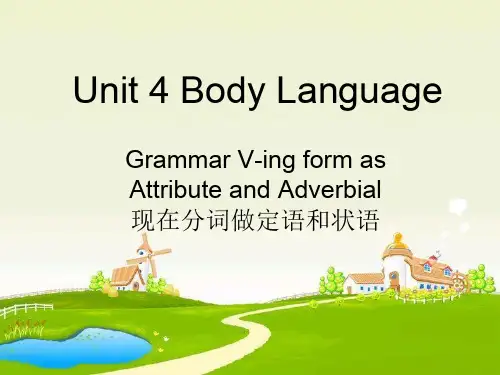
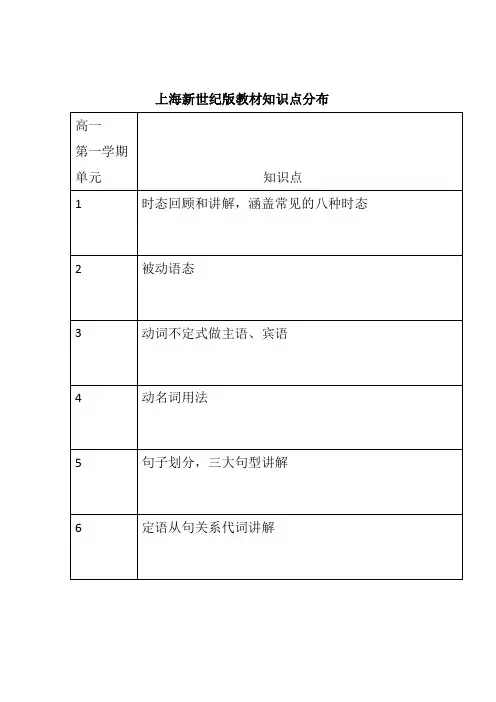
上海新世纪版教材知识点分布
高一
第一学期
单元知识点
1 时态回顾和讲解,涵盖常见的八种时态
2 被动语态
3 动词不定式做主语、宾语
4 动名词用法
5 句子划分,三大句型讲解
6 定语从句关系代词讲解
7 定语从句关系副词讲解
8 非限制性定语从句讲解
高一
第二学期知识点
1 动词+介词或副词短语的被动形式
2 动名词完成时态,having done, having been done
3 动名词被动式。
Being done
4 逻辑主语加动名词即动名词复合结构讲解
5 名词性从句主语从句讲解
6 表语从句讲解
7 同位语从句讲解
8 It做形式主语、形式宾语时用法
高二
第一学期知识点
1 现在分词作状语
2 现在分词作定语
3 现在分词做表语和宾语补足语
4 现在分词完成时做状语和定语
5 不定式完成式和进行时讲解
6 不定式的被动式讲解
7 过去分词做定语和状语
8 过去分词做表语和宾补
高二
第二学期知识点1 构词法简介
2 转化与合成构词
3 特殊句式中强调句讲解
4 含有助动词do+动词原形的强调句用法
5 部分倒装
6 全部倒装
7 情态动词+be doing
情态动词+have done用法
8 Should have done 用法。

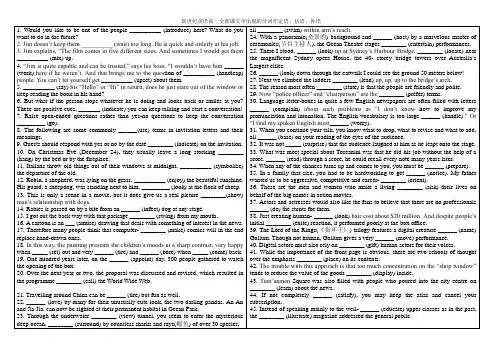
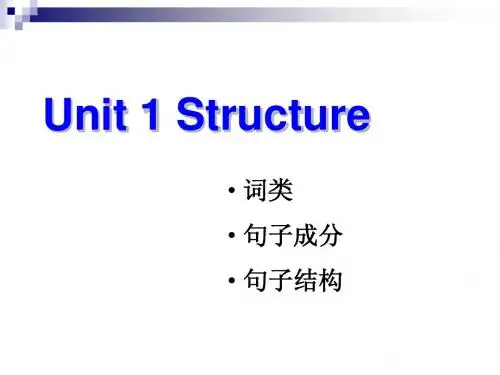
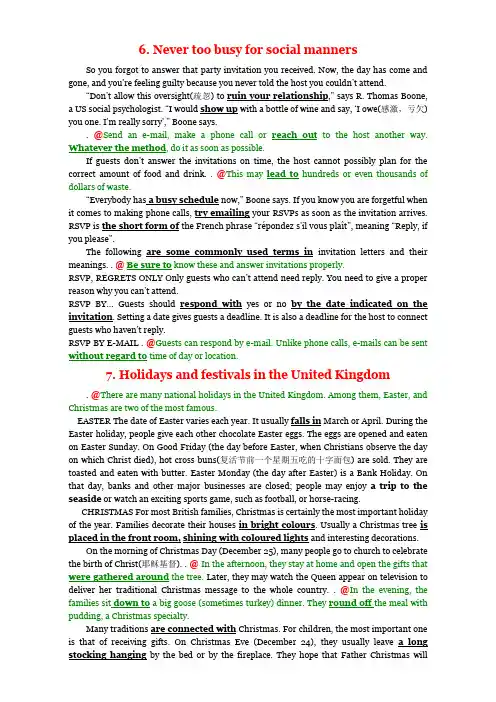
6. Never too busy for social mannersSo you forgot to answer that party invitation you received. Now, the day has come and gone, and you’re feeling guilty because you never told the host you couldn’t attend.“Don’t allow this oversight(疏忽) to ruin your relationship,” says R. Thomas Boone, a US social psychologist. “I would show up with a bottle of wine and say, ‘I owe(感激,亏欠) you one. I’m really sorry’,” Boone says.. @Send an e-mail, make a phone call or reach out to the host another way. Whatever the method, do it as soon as possible.If guests don’t answer the invitations on time, the host cannot possibly plan for the correct amount of food and drink. . @This may lead to hundreds or even thousands of dollars of waste.“Everybody has a busy schedule now,” B oone says. If you know you are forgetful when it comes to making phone calls, try emailing your RSVPs as soon as the invitation arrives. RSVP is the short form of the French phrase “répondez s’il vous plaît”, meaning “Reply, if you please”.The following are some commonly used terms in invitation letters and their meanings. . @Be sure to know these and answer invitations properly.RSVP, REGRETS ONLY Only guests who can’t attend need reply. You need to give a proper reason why you can’t attend.RSVP BY… Gue sts should respond with yes or no by the date indicated on the invitation. Setting a date gives guests a deadline. It is also a deadline for the host to connect guests who haven’t reply.RSVP BY E-MAIL . @Guests can respond by e-mail. Unlike phone calls, e-mails can be sent without regard to time of day or location.7. Holidays and festivals in the United Kingdom. @There are many national holidays in the United Kingdom. Among them, Easter, and Christmas are two of the most famous.EASTER The date of Easter varies each year. It usually falls in March or April. During the Easter holiday, people give each other chocolate Easter eggs. The eggs are opened and eaten on Easter Sunday. On Good Friday (the day before Easter, when Christians observe the day on which Christ died), hot cross buns(复活节前一个星期五吃的十字面包) are sold. They are toasted and eaten with butter. Easter Monday (the day after Easter) is a Bank Holiday. On that day, banks and other major businesses are closed; people may enjoy a trip to the seaside or watch an exciting sports game, such as football, or horse-racing.CHRISTMAS For most British families, Christmas is certainly the most important holiday of the year. Families decorate their houses in bright colours. Usually a Christmas tree is placed in the front room,shining with coloured lights and interesting decorations.On the morning of Christmas Day (December 25), many people go to church to celebrate the birth of Christ(耶稣基督). . @In the afternoon, they stay at home and open the gifts that were gathered around the tree. Later, they may watch the Queen appear on television to deliver her traditional Christmas message to the whole country.. @In the evening, the families sit down to a big goose (sometimes turkey) dinner. They round off the meal with pudding, a Christmas specialty.Many traditions are connected with Christmas. For children, the most important one is that of receiving gifts. On Christmas Eve (December 24), they usually leave a long stocking hanging by the bed or by the fireplace. They hope that Father Christmas willcome down the chimney during the night and bring them small presents. They are usually not disappointed!December 26, Boxing Day, is also a public holiday. . @This is the time to v isit friends or watch football. Students have several weeks off school for Christmas.Word study:P1 1. throughout +时间/ 事情/ 区域eg. throughout the day/ his illness/ the worldP2 2. vary vi. 改变(pt.pp. varied) vary in sth. 在…方面不同eg. People vary in intelligence.vary with sth. 随…而改变eg. The menu varies with the season.3. fall on 天/in 月,年: 恰逢…, 在….fall vi. (fell, fallen), n. 下降,跌落, 摔倒fall asleep / fall over摔倒/ fall behind落后P2 4. major adj. 主要的(作定语) 反义: minoreg. a major road 干路/ major achievements 主要的成就major n. 主修科目**majority n. most大多数,大半, Cf. main adj. 最主要的,首要的(无比较级,最高级)eg. The main thing to remember 要记住的主要内容The main course of a meal 一餐的主菜mainly adv. 主要地P2 5. trip n. 旅行(会回到出发地) eg. take a trip to Shanghaitravel (泛指“旅游”,指具体旅行时用复数形式) eg. journey (一般指长途旅行, 旅途)eg.. an uncomfortable journey in a crowed trainvoyage 和journey 相似,通常海上,航空旅行trip 一般指往返的短途旅行tour周游,视察,巡演exercise:•We made a long ___ to Hainan this summer vacation.•They are planning to have a weekend_____to Suzhou.•Her wish is to have a round-the-world_______.•He is fond of_______.•Did you enjoy the _______on sea?P3 6. celebrate vt. 庆祝eg. celebrate the birth of Christbe celebrated with 以…来庆祝7. encourage sb. to do 鼓励某人做某事discourage vt. 使人泄气courage n. 勇气8. drive away躯走,赶走eg.The bad weather has driven the tourists away.They smoked all night to drive away the mosquitoes.9.decorate vt.装饰decorate spl. with sth. decoration n. 装饰(不可数),装饰物(可数)10. gather vt.&vi. 聚集(人或事物聚集起来)Cf.collect vt. 收集(事物)gather books 把书集中在一起gather stampscollect books 收集图书collect stamps11. sit down to (prep.)in addition to pay attention todevote oneself to be used to doinglead to turn to sb. for helplook forward to get down to business 开始做正事12.follow vt. 跟随,遵照,听懂eg. A big goose dinner is followed by Christmas pudding.He followed the directions. 他遵照了指示.I can’t follow you. Please read it slowly.as follows 如下following adj.以下的13.deliver a message/lecture /speech/talk to sb. 发表讲话deliver vt. 递送deliver sth. to sb.delivery n. 递送,投递,交付(货物,信件)14. be connected with 与…有关,有联系eg. There are many traditions that are connected with Christmas.are related toThe fall in the cost of living is connected with the drop in the oil price.He has been connected with the publishing house since 1990..15.leave vi&vt. 让…继续处于某种状态leave sb./sth. + 现在分词: eg. They leave a stocking hanging by the fireplace.leave sb./sth. + 过去分词: eg. Don’t leave the door unlocked. 别不锁门.leave sb./sth. + 形容词: eg. you’d better leave the window open / closed.leave sb./sth. + 介词: eg. They leave a stocking by the bed.16.hope that 从句eg.They hope that Father Christmas will come down the chimney during the night and bring them small presents.hope to do ( 错: hope sb. to do ) eg.hope for sth. 希望得到eg.17.This is the time to do 是做…的时间It’s time to do / for sth.18. off adv.&prep. (因病,假日等原因)不工作/学习(adv.): have …(some time) off eg. have a month off(prep.): off work/ schooleg. several weeks off school for Christmas.He is off work now. 他现在不工作.Translation1.有些物品的价格随季节变化而浮动.( vary with)2.中华美食有四大菜系.(major)3.2011年的春节将出现在1月16日。
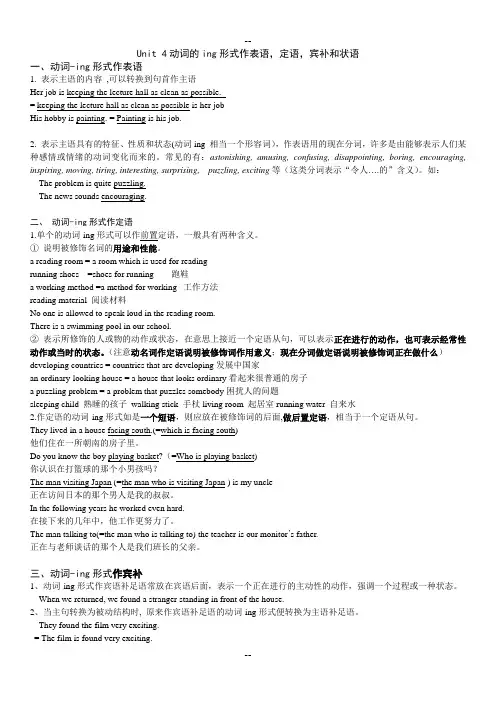
Unit 4动词的ing形式作表语,定语,宾补和状语一、动词-ing形式作表语1. 表示主语的内容,可以转换到句首作主语Her job is keeping the lecture hall as clean as possible.= keeping the lecture hall as clean as possible is her jobHis hobby is painting. = Painting is his job.2. 表示主语具有的特征、性质和状态(动词ing 相当一个形容词),作表语用的现在分词,许多是由能够表示人们某种感情或情绪的动词变化而来的。
常见的有:astonishing, amusing, confusing, disappointing, boring, encouraging, inspiring, moving, tiring, interesting, surprising, puzzling, exciting等(这类分词表示“令人….的”含义)。
如:The problem is quite puzzling.The news sounds encouraging.二、动词-ing形式作定语1.单个的动词-ing形式可以作前置定语,一般具有两种含义。
①说明被修饰名词的用途和性能。
a reading room = a room which is used for readingrunning shoes =shoes for running 跑鞋a working method =a method for working 工作方法reading material 阅读材料No one is allowed to speak loud in the reading room.There is a swimming pool in our school.②表示所修饰的人或物的动作或状态,在意思上接近一个定语从句,可以表示正在进行的动作,也可表示经常性动作或当时的状态。


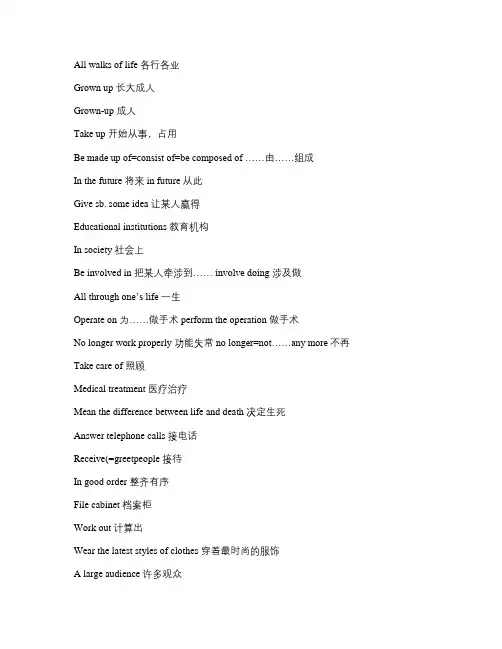
All walks of life 各行各业Grown up 长大成人Grown-up 成人Take up 开始从事,占用Be made up of=consist of=be composed of ……由……组成In the future 将来 in future 从此Give sb. some idea 让某人赢得Educational institutions 教育机构In society 社会上Be involved in 把某人牵涉到…… involve doing 涉及做A ll through one’s life 一生Operate on 为……做手术 perform the operation 做手术No longer work properly 功能失常no longer=not……any more不再Take care of 照顾Medical treatment 医疗治疗Mean the difference between life and death 决定生死Answer telephone calls 接电话Receive(=greetpeople 接待In good order 整齐有序File cabinet 档案柜Work out 计算出Wear the latest styles of clothes 穿着最时尚的服饰A large audience 许多观众A large number of +[C]Follow trends 赶时髦Dress sb. / dress oneself 为某人穿衣 be dressed in 穿着……Admire sb. For sth. 因……佩服某人(n.)admirationAt the end of 在……末In fact=actually=as a matter of fact 事实上High school graduate 高中毕业Practice medicine 行医Even though 虽然,尽管Insist on doing 坚持做某事Insist that + clause 坚持说Insist that … (should do 坚持要求Make up one’s mind 下决心On (theone hand 一方面On the other hand 另一方面Disagree with 不同意Right now 立即Attitude towards 对…态度Be grateful to sb. For sth. 为…感谢某人Force sb. to do 强迫某人做某事Take an interest in 对…产生兴趣Make a decision 做决定(all on one’s own 独立的Give up doing 放弃。

1. People from all walks of lifeWhen a person grows up, he will take up different occupations in various work places. A society is thus made up of all walks of life. What kind of person do you want to be in the future? The following introductions may give you some idea.TEACHER Teachers are professionals. They work in schools, colleges, universities and other educational institutions. They try their best to help students gain new knowledge and become useful people in society. Teachers are involved in many tasks, such as explaining lessons, giving homework and correcting papers. At the end of every term, they mark test papers and give grades to their students. Actually teachers do more. Often their impact on students stays all through their lives.SURGEON Surgeons, like teachers, are also professionals. As a special group of doctors, surgeons operate on sick people and repair the organs that no longer work properly. Hospitals are their work places. After an operation, a surgeon takes care of the patient‟s medical treatment until he gets well. The skills of a surgeon sometimes mean the differences between life and death. SECRETARY A secretary works in an office. The job of a secretary often involves writing letters, answering telephone calls, and receiving people. A secretary stores information on a computer and puts papers in good order in file cabinets. As a link between the boss and the visitors, a secretary also helps the boss work out plans and timetables. Traditionally, more girls than boys work as secretaries.FASHION MODEL Fashion models wear the latest styles of clothes and show them to us through television, newspapers and magazines. Fashion show programmes usually have a large audience. The clothes and hairstyles of fashion models may seem strange to the elderly, but a large number of young people enjoy following trends and want to be dressed like the models. They collect fashion pictures and admire those superstars of the catwalk.Would you like to be one of the people introduced here? What do you want to do in the future?2. What to choose?Today more and more high school graduates go on to college. Most young people decide their courses of study for themselves. They do not wait for their parents to tell them what career to choose.For example, Jack‟s father practices medicine. Even though he wants his son also to become a doctor, he doesn‟t insist that Jack study medicine when he finishes high school.He believes that Jack must make up his own mind about his courses of study. His wife, on the other hand, disagrees with him. She thinks that Jack should become a doctor, and so he can become a partner with his father.Jack isn‟t sure what he wants to study in college. One day he feels that he‟d like to become an engineer. However, the next day he thinks that perhaps he should study business management. Right now he is studying chemistry, biology, and physics. All of them will be useful if he finally chooses to study medicine in college.Jack likes his father‟s attitude, and is grateful that his father isn‟t forcing him to become a doctor.In some countries parents often decide what careers their children will follow --- especially their sons. Tchaikovsky(柴可夫斯基,1840-1893,俄国作曲家), the composer of Swan Lake(芭蕾舞剧《天鹅湖》), was asked to study law. He, however, didn‟t take an interest in it. Tchaikovskymade a great decision on his own. He gave up his government service later and started to study music.Some people think the young are probably going to be successful because they are doing the things they most want to do in life. Many people, however, disagree with them.3. MichelangeloMichelangelo(米开朗琪罗,1475-1564,意大利文艺复兴时期成就卓著的科学家、艺术家) was an Italian artist about 500 years ago. Today he is still remembered as a great sculptor, painter, and architect.Michelangelo came from a poor family. He was trained at an early age like any other craftsman in Italy. At thirteen, he started to work and learn in a workshop. The workshop belonged to one of the leading masters at that time. In the workshop Michelangelo was able to learn all the skills of sculpture. However, he wasn‟t satisfied, and went on to study the work of the great masters of the past. Michelangelo worked hard and he mastered one problem after another. By the time he was 30, he was generally regarded as one of the outstanding sculptors of the age.In 1508, Michelangelo was given a task --- to paint the ceiling of the Sistine Chapel(位于罗马梵蒂冈的西斯廷教堂). At first, he tried to turn down this job, saying that he was not really a painter, but a sculptor. Finally, he agreed to do it. He then shut himself up in the chapel, let no one come near him, and got ready to work alone.It took him four years to complete the paintings on the ceiling. Any ordinary person would find it hard to imagine what Michelangelo had gone through in those four years of hard and lonely work. Michelangelo, while working, had to lie on his back and paint. As a result, he became so used to looking upward that when he received a letter during that period, he had to hold it over his head to read it. Finally, the paintings were completed. The great and huge paintings on the ceiling and walls of the chapel have ever since become a fascination to people in Italy and all over the world.Michelangelo left us with a great number of sculptures and paintings. Today his works are still examples for art students to study and follow. Home and overseas visitors can‟t help but admire these masterpieces.4. Jim CorriganJim Corrigan, a well-built man in his late 20‟s, works in a large hospital. Jim is an X-ray technician. It is his job to develop the many X-ray films that are taken of people‟s lungs, stomachs and other body parts.Jim works in a darkroom, a room that is specially equipped for developing film. First he removes the film from the lead plates(金属片) that are used to hold it. Then he feeds the film into a developing machine. It takes about 90 seconds for it to develop. The film is then ready to be examined by a doctor.Jim‟s work is important, and both doctors and patients eagerly, often worriedly, wait for the result s of his work. Jim doesn‟t keep them waiting too long. He is quick and orderly at his job. This would not be unusual except for the fact that Jim Corrigan is blind.“In the beginning it was tricky,” Jim explains, “The film comes in five different sizes. An d sometimes I would get them mixed up. But I have never let a mistake get out of the darkroom.” After some time, Jim learned to measure the film by running his fingers over the edges.“I have a system,” explains Jim, “so that I can find things easily in the darkroom. It‟s a simple system. I just keep my materials in order and put them back in the same place after I usethem. I don‟t have to search for anything.”“Jim is quite capable and can be trusted,” says his boss, “I wouldn‟t have him working here if h e weren‟t. And that brings me to the question of handicapped people. You can‟t let yourself get upset about them. They want to be treated just like anybody else --- and they should be. They don‟t want you to fell sorry for them.”No one has to feel sorry for Jim Corrigan.5. Starting a conversation with a foreigner in EnglishAs you rode on the bus one day, a foreigner sat down beside you. Finally, here was a perfect opportunity for you to practice speaking English with a foreigner, you thought to yourself. But no words came into your head. You were tongue-tied! After 15 minutes, the foreigner got off the bus and you didn‟t utter a word! “What a shame!” you said to yourself.If you have had such an experience, don‟t feel bad. You‟re not alone. What you need is a lesson in small talk. Here are some tips that will show you how to get started.“HELLO” --- A STARTER First, exchange a “Hello” or “Hi” with the foreigner, but at the same time, pay close attention and see if he feels like chatting. Watch his facial expression and body language for cues. Having said his “Hello” or “Hi” in return, does he just stare out of the window or keep reading the book in his hand? That‟s the cue for you to stop moving on. Don‟t force a conversation on someone who wants to be left alone.But what if the person stops whatever he is doing and looks back or smiles at you? These are positive cues, indicating you can keep talking and start a conversation!SMALL TALK --- THE MAIN COURSE To start a conversation, you should choose a suitable topic. Then, what are the rules for choosing a suitable topic?Perhaps the most universal topic of any conversation is the weather. Everyone has an opinion to share about the weather! Don‟t immediately launch into serious topics like politics or religion. And don‟t talk about personal matters, either. Stick to familiar subjects of a casual nature such as movies, music, sports, favourite things, or one‟s likes and dislikes.Small talk flows naturally. Raise open-ended questions rather than yes-no questions to keep the conversation going. Try to find points of connection between you and the person you are chatting with. Offer short comments on what the other person says, and listen attentively when what you say is being commented on. If you get such comment s as “That‟s interesting.”, “I agree.”, or “Me too.” then you know you‟re on the right track.You can have a lot of fun chatting in English with foreigners. They will, too. Try it! Making small talk can be one of life‟s pleasures.6. Never too busy for social mannersSo you forgot to answer that party invitation you received. Now, the day has come and gone, and you‟re feeling guilty because you never told the host you couldn‟t attend.“Don‟t allow this oversight(疏忽) to ruin your relationship,” says R. Thomas Boone, a US social psychologist. “I would show up with a bottle of wine and say, …I owe(感激,亏欠) you one. I‟m really sorry‟,” Boone says.Send an e-mail, make a phone call or reach out to the host another way. Whatever the method, do it as soon as possible.If guests don‟t answer the invitations on time, the host cannot possibly plan for the correct amount of food and drink. This may lead to hundreds or even thousands of dollars of waste.“Everybody has a busy schedule now,” Boone says. If you know you are forgetful when itcomes to making phone calls, try emailing your RSVPs as soon as the invitation arrives. RSVP is the short form of the French phrase “répondez s‟il vous plaît”, meaning “Reply, if you please”.The following are some commonly used terms in invitation letters and their meanings. Be sure to know these and answer invitations properly.RSVP, REGRETS ONL Y Only guests who can‟t attend need reply. You need to give a proper reason why you can‟t attend.RS VP BY… Guests should respond with yes or no by the date indicated on the invitation. Setting a date gives guests a deadline. It is also a deadline for the host to connect guests who haven‟t reply.RSVP BY E-MAIL Guests can respond by e-mail. Unlike phone calls, e-mails can be sent without regard to time of day or location.7. Holidays and festivals in the United KingdomThere are many national holidays in the United Kingdom. Among them, Easter, and Christmas are two of the most famous.EASTER The date of Easter varies each year. It usually falls in March or April. During the Easter holiday, people give each other chocolate Easter eggs. The eggs are opened and eaten on Easter Sunday. On Good Friday (the day before Easter, when Christians observe the day on which Christ died), hot cross buns(复活节前一个星期五吃的十字面包) are sold. They are toasted and eaten with butter. Easter Monday (the day after Easter) is a Bank Holiday. On that day, banks and other major businesses are closed; people may enjoy a trip to the seaside or watch an exciting sports game, such as football, or horse-racing.CHRISTMAS For most British families, Christmas is certainly the most important holiday of the year. Families decorate their houses in bright colours. Usually a Christmas tree is placed in the front room, shining with coloured lights and interesting decorations.On the morning of Christmas Day (December 25), many people go to church to celebrate the birth of Christ(耶稣基督). In the afternoon, they stay at home and open the gifts that were gathered around the tree. Later, they may watch the Queen appear on television to deliver her traditional Christmas message to the whole country. In the evening, the families sit down to a big goose (sometimes turkey) dinner. They round off the meal with pudding, a Christmas specialty.Many traditions are connected with Christmas. For children, the most important one is that of receiving gifts. On Christmas Eve (December 24), they usually leave a long stocking hanging by the bed or by the fireplace. They hope that Father Christmas will come down the chimney during the night and bring them small presents. They are usually not disappointed!December 26, Boxing Day, is also a public holiday. This is the time to visit friends or watch football. Students have several weeks off school for Christmas.8. How do different cultures around the world celebrate the New Year?Get ready to say good-bye to the old, hello to the new! What‟s the occasion? The coming of the New Year.Many Western cultures measure their days with the solar calendar. Therefore, they observe the coming of New Year on January 1. Cultures in Asia and Middle East use other calendars, such as the more ancient lunar calendar. They celebrate the New Year at other times.Events and ceremonies vary from country to country. But in each places, New Year celebrations are a big meal.Most world cultures have been celebrating the New Year for centuries. The earliest New Yearcelebrations took place during spring or harvest time. With better weather ahead, or plenty of food to eat in winter, people naturally felt like having a party!As the days became longer and as nature renewed itself, people also felt like they could have a new start. Past disappointments could be forgotten. The New Year could bring better fortune, more opportunities and new challenges. Such universal themes remain the same today.Some cultures have unusual New Year traditions. Italians throw old things out of their windows at midnight, symbolizing the departure of the old. Mexicans fire guns into the air to keep away misfortunes.New Year celebrations also involve having fun. Some cultures view the New Year as an opportunity to let off fireworks. In New York City‟s Times Sq uare, thousands gather on December 31 to count down the last seconds of the year. A giant silver ball is lowered at the stroke of midnight.London, England, hosts an annual New Year‟s Day parade that draws nearly a million spectators. The largest parade in Europe, it features bands and enormous balloons. These balloons are so huge that they tower over nearby buildings!How will you celebrate the New Year? Think about the themes you find meaningful during this season. Do you hope for a new start or a chance to turn over a new leaf? whatever the case, we wish you well. Happy New Year!9. Man’s four-legged friendThe sun was shining and it was warm. Robin, a shepherd, was lying on the grass, enjoying the beautiful sunshine. His guard, a sheepdog, was standing next to him, looking at the flock of sheep.This is only a scene in a movie, but it does give us a real picture showing man‟s relationship with dogs. For a long time in history, dogs were not only being raised to work as man‟s guards, but they were also being trained to do many other jobs. Some were made to pull carts; others were bred to smell out enemies or track the scent of big animals. In addition to these hunting and working dogs, other breeds came to be used in sports, police work and as pets as well. In a way dogs have become man‟s friends and working partners.If you have a dog you love as a pet, you share some of your life with it. The dog lives in your home, keeps you company and goes on trips with you. Dogs rely on their excellent sense of smell to tell things apart. This sharp sense helps man and dogs themselves get over a lot of difficulties.A detective once trained a dog---Sauer. In 1925 while he was thinking hard about how to catch a thief. Sauer worked alone and tracked the thief after covering a distance of 160 kilometres. Sauer did this by scent alone. In 1923 a couple lost their dog Bobbie while they were travelling. Six months later Bobbie turned up at the family house. He had covered a distance of some 3,200 kilometres. The dog had travelled back through the Rocky Mountains in the depths of winter.Dogs are indeed man‟s best friends. Yet sometimes even the friendliest dog can bring death with its bite! This is not because it has changed in character, but because it has been infected with a terrible disease---rabies(狂犬病). The disease is passed on by a bite from an infected dog at any stage. When an infected person shows symptoms, death is certain to follow shortly after. So, in order to prevent the disease, a person should go to a doctor at once if he has been bitten by a dog. Dogs remain man‟s best friends, but we should also try our best to guard against the horrible disease that can be carried by these friends.10. Well done, Spotty!We were walking alone when we saw the Wilkins‟ children playing in their yard. The three girls were taking turns pushing a cart. Their one-year-old twin brothers and a big doll were in it. Just as we walked by them, a wheel came off. Freckles, my friend, fixed it for them. Then they all went upstairs to play some games. After a while Mrs Wilkins went out, and left the twins with the girls.Well, it wasn‟t much fun for me, and soon I went to sleep.I must have slept pretty hard and pretty long. All of a sudden I woke up and could hardly breathe. Everybody was gone. The room was full of smoke! The house was on fire!I started down the stairs and stumbled over a gray bunch. “That belongs to Freckles,” I thought. “It‟s the gray sweater that he likes so much. I might as well take it down to him.”I took the sweater in my mouth and started down again. It weighed so much. So I dropped it on one of the stairs. Then I went back up to look out of a window. I wanted to see why there was so much noise.The whole town was in the front yard and in the street! In the middle of the crowd was Mrs Wilkins, who was carrying on like a mad woman. Mr. Wilkins was jumping up and down and shouting loudly, “I‟ve got the babies! I‟ve got the babies!” He had a real baby in one arm and the big doll in the other. He was so excited that ha thought he had both babies.Later I heard what had happened. The kids had thought they were escaping with both twins. But one of them had saved the doll and left a twin behind.“Well,” I decided, “I‟d better get out of here fast. This place is really beginning to burn!” As I ran down the stairs, I knocked into the gray bunch again. So I picked it up.I got out the back way with that package swinging from my mouth. I walked round to the front yard and set it down very quickly. It let out a cry!“My baby!” shouted Mrs Wilkins. And she star ted to kiss me and the babies.“Three cheers for Spotty!” everyone shouted at the top of their voices.The butcher made his way through the crowd and gave me a large piece of hamburger and said, “It‟s got chicken livers mixed in it.”I liked the way things were, so I wagged my tail.11. Cartoons and comic stripsPeople often find it hard to put their feelings into words. So they keep hunting for new means of expressing their feelings other than words. Cartoons, as such a means, were thus born. Old cartoons, however, did not attract many people until cartoonists had expanded their topics by the end of the 19th century. At around the same time, comic strips came into being.A cartoon is an amusing drawing that deals with something of interest in the news. Comic strips are a set of humorous drawings that tell a funny story. They make a story appear as a picture in the reader‟s mind by showing one or two aspects of an event.There is a cartoon that shows a father and his son. The boy is showing his father his school report, which, unfortunately, gives a very poor grade---2 out of 5. So he does it in a quite unusual way: the report is fastened to one end of a pole while the boy is holding the other and. With the long pole between them, any punishment from the father is out of the question. For the moment, at least, the son is safe.Readers can‟t help laughing at the cartoon. But they may also find some food for thought in addition to being amused.Reading cartoons and comic strips had long been a favourite pastime for adults until thebeginning of the 20th century. Then some business-minded people found that there might be a good market for children, too. With the improvement of printing and drawing techniques, modern cartoons and comic strips had become children‟s f avourites by the early 20th (around the 1920s). Since then they have become popular reading materials for people of all ages.Today the characters in cartoons and comic strips range from children to adults, pets to fancy animals, and ordinary people to superheroes. Micky Mouse and Garfield the Cat make children think and imagine actively. Superman and Batman bring villains of all sorts to justice. Father and Son expresses human love and sympathy in lively comic strips. Their names have become household words. They are only a few outstanding products in the field.Today the digital revolution has brought new life to the making of cartoons and comic strips. Therefore many people think that computer-made comics will in the end replace hand-drawn ones. However, just as the human mind will never give way completely to the computer, hand-drawn comics will never die, but will remain a special means of expressing human feelings.12. Rockwell and his worksNorman Rockwell was a famous American illustrator and cover artist. Many of his works had become well-known by the middle of the 20th century. Critics spoke highly of his works. For example, according to one critic, “Most artists affect us by surprising us. Rockwell affects us by giving us exactly what we expect.” Th e following are just a few examples of his magazine covers. Cover one One of the best-known of all Rockwell‟s covers! This painting is made up of two parts: the upper and the lower. Each detail in the lower picture is carefully matched with something in the upper part, so the result is kind of humorous. In this way, the painting presents the children‟s moods in a sharp contrast: very happy when setting out and very tired and bored when coming back.Cover two This painting shows Rockwell‟s skills as a story teller. It tells an ordinary story about a school boy. The boy is busy with his studies. Outside the window a fishing pole is ready, and the boy‟s dog is waiting impatiently. To the boy, these last days of schoolwork before the summer vacation seem the longest. They appear more so as the final examination is drawing near. This is an old story of school children, but Rockwell tells it vividly in a simple way.Cover three In this painting, a young mother is trying hard to make up her mind: to spank or to spare her naughty child. The broken clock on the floor suggests that the child has behaved in an entirely natural manner. When a hammer is within his reach, he breaks something with the hammer! At the time the painting was completed, the Rockwells were already parents. So the cover story perhaps describes the artist‟s own life experience. With this experience, Rockwell could make every detail come alive in this painting.13. A brief look at two metropolisesNEW YORK In the 19th century, a businessman predicated that New York was going to become the centre of the world. His prediction has partly come true. Today, New York is often regarded as one of the financial and cultural capitals of the Western World. The United Nations has its headquarters in the city as well.New York, where the world-famous twin towers of the World Trade Center were once located, is known as a city of skyscrapers. There are parks, great museums, art galleries, grand theatres and cinemas for visitors as well. However, like many other cities in the world, New York also has its own problems---noise, air pollution, crimes, traffic jams, and slums. Still, the fast, exciting pace of life in New York City is fascinating and this may be a reason why the city continues to fascinatemore and more people.LONDON London was once known as a city of fog. At that time, many Londoners did not expect that their city would change for the better. However, heavy fog is now rarely seen in London.As a city with a long history, London has also gone through many changes. The days are gone when horse-drawn carriages were a common sight in the street. Now London is famous for its excellent underground service and the red double-deckers have become a symbol of the city. The second half of the 20th century saw great changes in the city. Skyscrapers have sprung up; business centres for the 21st century are also growing fast.However, London has kept its heart. People can still enjoy themselves with a cup of tea in Convent Garden(科文特加登广场). Some of the narrow roads that lead to churches are still there, taking people back to London‟s old days. Although there are such concerns as heavy traffic, crowded shops and dirty streets in some areas, to many people, London remains the most interesting and wonderful city in the world.14. The time capsule of Colorado SpringsIn 1901, the citizens of Colorado Springs(科罗拉多泉市) in the USA decided to collect everyday items and to seal them in a steel box. The box was marked “To be opened after midnig ht, December 31st, AD 2000”, and was stored in the Colorado College Library.One hundred years later, on the appointed day, 300 people gathered to watch the opening of the box. Many in the crowd were in very good condition. There were newspapers, photographs, diaries, name cards, family trees, books and dozens of letters, including one written by Theodore Roosevelt(西奥多·罗斯福,美国第26任总统), who became the President of the USA later that year. One of Roosevelt‟s friends lived in Colorado Springs at that time.Many of the letters were addressed to their descendants. They describe the hopes that the people of 1901 had for the people of the next century. At that time, Colorado Springs had just a few thousand residents. Now nearly half a million people live there.Colorado College Library has scanned the materials and put them on a website. Cecil Muller, whose grandfather had placed a collection of postcards in the box, said that the time capsule was a great treasure. “This is a wonderful educational resource. We can learn so much about our history,” he said. “I never knew my grandfather, but now I feel close to him.”In April 2001, a committee filled the time capsule with items from modern Colorado Springs and resealed it for another hundred years.15. The growth of the InternetThe Internet began as a tool to connect universities and government research centres through a nationwide network. It would allow a large number of computers to exchange information and share resources. Its development was pushed forward by ARPA---the Advanced Research Projects Agency, which was established in the United States in 1958. In 1969 ARPA began to focus on communications technology. Then in the early 1970s, the ARPA net came into being. This network laid the foundation for the Internet. In 1972, electronic mail was introduced.At the same time in Europe, researchers were struggling with their own computer networking problems. In 1989, a scientist proposed the World Wide Web project. Over the next year or two, the proposal was discussed and revised, which resulted in the programme called the World Wide Web. In 1992, its browser software was introduced to the public.The early browsers functioned well but were not “user-friendly”. In 1993, a group of graduated students in the USA created Mosaic---a “browser” programme. Mosaic was pleasing to。
UNIT 3TEXT1.to start with= to begin with 首先2.on the bus 在车上by bus 乘车3.practise doing 练习做4.think to oneself 心里想5.come into one’s head 想到。
,产生(某想法)=come into one’s mind=occur to sb.=occur to one’s mind6.What a shame 真遗憾!多可惜啊!7.feel shame at 对。
感到羞耻,遗憾feel ashamed of8.small talk 闲谈,聊天9.get started 开始10.exchange sth with sb 与某人交换某物exchange A for B 用A换B11.at the same time 同时12.pay close attention to sb/sth 注意观察某人/事,仔细听某人讲的话call one’s attention 唤起某人的注意catch one’s attention 吸引某人的注意13.feel like doing 想要做=would like to do=want to do14.in return 作为回报15.stare at 盯着看glance at 瞥一眼glare at 怒视16.keep doing 继续做某事,一直/重复做某事17.move on 继续进行18.force sth on sb 把。
强加给某人19.leave sb/sth alone 不打扰,不干预某人(某事物)sb. be left alone 不被打扰20.what if :wha t will/would happen if… 如果。
将会怎么样21.be suitable for 适合于22.share sth with sb 与某人分享某事23.a share of 一份24.launch into 突然开始25.personal matters = private affairs 私事26.stick to 紧扣主题,坚持,坚守27.rather than 而不是28.try to do 尽力做29.points of connection 共同点30.chat with sb. about sth. 与某人就某事聊天Have a chat with sb.31.comment(v. on 对。
动名词的复习senior one2009-02 动名词—非谓语动词中-ing分词的一种I.动名词的构成II.动名词的否定:not + doingI regret not being able to help you.Would you mind not smoking?III.动名词的复合结构:形容词性物主代词/名词所有格+ doingYour going there won't help much.I remember Zhang Hua's coming here.*当这种复合结构不处于句首时,也可以用人称代词的宾格或者名词的普通格Do you mind my/me opening the window?He suggested Helen's/Helen doing it herself.IV.动名词的语法功能1・作主语(也可以用形式主语it,将动名词放在句末)只有少数形容词或者名词,才会用动名词作主语:no use/good, not any use/good, uselessIt is useless trying again. = Trying again is useless.It is no good crying over spilt milk.2.作宾语(包括动词宾语和介词宾语)My grandma enjoyed raising flowers.They think of going there in the autumn.He left without saying good-bye to us.Is there any hope of catching the early flight?*必须用动名词作宾语的动词*在动词think, consider, find后常用it作形式宾语,将动名词(句子的真正宾语)放在句末。
I don't think it any good having too many sweets.He found it useless talking it over with her.3.作表语动名词作表语说明主语是什么,主语和宾语的位置常可交换。
1、上次课后巩固作业复习;2、互动探索此环节教案预期时间15分钟教学建议:1.老师根据图片内容问学生问题,让学生至少说出3个句子来回答。
2.问学生这些句子分别由哪些结构组成并导出本节课要学习的知识:句子结构及句子类型。
T: What will you do in Halloween? (疑问句)S: I will hold a big party with my friends (主谓宾), dressing up in costumes. Sometimes I will go from house to house dressed in my favorite costume(主谓状)- Spiderman, asking for treats like candy or toys from my neighbors. Of course, they are all young people(主系表)and love this festival very much.(此部分内容包含本次课所学内容相关的练习题及综合练习题。
建议题量保持在30分钟左右可以完成的范围内)1. Don't drink too much coffee in the evening, ____you won't fall asleep.A.and B.or C.but D.so2. Study hard, ____you will catch up with others.A.and B.or C.but D.so3. Could you tell me ____we will have a discussion tomorrow?A. whomB. thatC. whatD. where4. My sister asked me____ kite____.A. who...this was B.whose... this was C. whose...was it D. who...was this5. "Have you returned the book to the library?" “What did she ask?" “She asked ____,”18.【解析】答案是A。